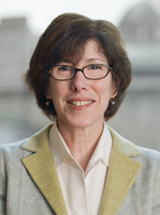President’s Messageby Jeanine P. Wiener-Kronish, MD
Winter 2018 NewsletterThe AUA 2018 Annual Meeting—co-hosted by Northwestern University Feinberg School of Medicine and The University of Chicago Medicine—in Chicago, Illinois, will soon commence. Education Advisory Board (EAB), Scientific Advisory Board (SAB), and the Host Institution Chairs, Drs. Robert R. Gaiser, Y.S. Prakash, Jeffrey L. Apfelbaum, and Charles W. Hogue, have organized a thought-provoking program addressing the latest breakthroughs and trends in academic anesthesia and the practice as a whole. For an in-depth look at the meeting, please review the preliminary program. I recently provided an AUA update to the ASA Monitor. On the eve of our 2018 Annual Meeting it seems particularly fitting to share the contents of the article. The Association of University of Anesthesiologists was started in 1953 and its first meeting was held on January 9, 1954 at the Massachusetts General Hospital. The goal was to help Anesthesiologists to network and highlight achievements in academic anesthesiology. Over the last five years, the ability of this organization to achieve its goals has been enhanced due to the concerted efforts of many people, particularly Drs. Debra Schwinn, Lee Fleisher, Alex Evers, and Tony Jones. The AUA formally aligned with the IARS (International Anesthesia Research Society), and annual meetings are now co-located. There are now several joint activities between the AUA and IARS, including presentations of new science. This alignment has promoted improved networking and collaboration among international academic leaders in anesthesiology. The Society of Critical Care Anesthesiologists (SOCCA) has also aligned its annual meeting with the IARS meeting, which has facilitated interactions between AUA members and leaders in critical care anesthesiology. Of note, the three organizations (AUA, IARS and SOCCA) now cooperate in organizing an aligned meeting day on the Saturday of their annual meetings, incorporating academic content that is of interest to members of each organization. This partial integration of the meetings has led to a substantial increase in attendees at all meetings, and increased satisfaction with the programs offered. The AUA is now hosting an increasing number of faculty involved in education research, which is one of the highlights of the AUA program. The AUA gives an annual donation to FAER, as the AUA collaborates with all groups that foster the careers of academic anesthesiologists. Most recently attention has been paid to younger academic faculty and trainees, and anesthesiology scholars with diverse backgrounds and interests formed the early-Stage Anesthesiology Scholars (eSAS) group. Drs. Mashour and Avidan obtained an NIH R13 grant to promote the success of anesthesiology scholars through meetings and mentorship. A Scholars’ Program now occurs annually during the AUA/IARS/SOCCA meeting and is open to scholars associated with all three organizations. The AUA has also opened its doors to a new category of membership, called associate members. These are early stage faculty on training grants, or grant holders from FAER, IARS or other organizations. This associate membership group reflects the investment of the AUA in the future of academic anesthesiology. There are now 83 associate members in the AUA, and they have certainly injected new energy into the organization. National consortiums have been created to help these young faculty network and succeed in their academic careers. The number of NIH training grants in Anesthesiology has doubled over the last 10 years. This is a sign of the increased interest in and commitment to research in our field. Anesthesiologists today are as successful as Medicine and Surgery applicants in obtaining NIH funding. Finally, the AUA is attempting to increase clinical research in our field by offering three $15,000 prizes for project proposals. A panel of judges has been assembled that reflects experts in clinical research in anesthesiology, and the hope is to create a national consortium of programs that can undertake world-class clinical research. Dr. Avidan has been instrumental in creating this program, which will begin on May 1, 2018 at the IARS meeting. The AUA/IARS/SOCCA meetings are devoted to highlighting the science of translational and clinical research, and education advances in our field. The 2018 meetings feature scientific projects on sepsis, mitochondria, machine learning, and evidence-based education. The goal is to make the meetings an essential destination for all those committed to the future of the specialty. Author |


